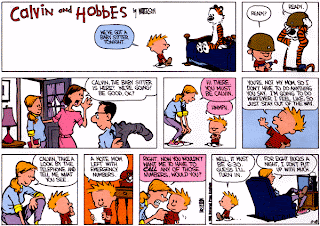 Chapter 14: Hobbes
Chapter 14: Hobbes
1.
Watterson has written of his strip, "My strip is about private realities, the magic of imagination, and the specialness of certain friendships." (1) The specialness of certain friendships. If Calvin and Hobbes has a theological core it is the friendship that sits at the center of the strip. More than anything, Hobbes is Calvin's best friend. Hobbes functions as companion, gadfly, antagonist, cheerleader, comforter, and conscience. Watterson goes on to say, "Hobbes is my idea of an ideal friend." (2)
2.
The "gimmick" at the heart of the strip is the ontological status of this ideal friend. Is Hobbes real? Or just a product of Calvin's imagination?
When we see Calvin and Hobbes alone we see Hobbes as "real." Not just alive, but having real effects in the world. A causal agent. But when Calvin and Hobbes are with other people we see Hobbes as a stuffed tiger.



Watterson is very playful with this blurring of the lines between the subjective and objective. One of my favorite examples of this is an early storyline when Calvin looses Hobbes:

Eventually, Susie finds Hobbes:
And plays "girl games" with him (which, by the way, as Calvin's alter ego, Hobbes always likes):
Calvin eventually finds (saves?) Hobbes:
Notice the ontological twist in the last frame. Who ate those cookies? The stuffed tiger?
3.
In his comments about the strip Watterson has refused to resolve the ontological issues surrounding Hobbes. Watterson has written,
I don't think of Hobbes as a doll that miraculously comes to life when Calvin's around. Neither do I think of Hobbes as the product of Calvin's imagination...Calvin sees Hobbes one way, and everyone else sees Hobbes another way. I show two versions of reality, and each makes complete sense to the participant who sees it. I think that's how life works. None of us sees the world in exactly the same way, and I just draw that literally into my strip. Hobbes is more about the subjective nature of reality than about dolls coming to life. (3)4.
If we take Watterson at his word it is clear that he is discussing ontology in his strip. He shows "two versions of reality." He rejects the notion that the strip is "magical" or that Hobbes is just imaginary. Rather, Watterson is playing with the dual realities of subjective and objective experience. And, as he says, he draws these dual realities "into the strip."
There is a great deal of debate as to whether God exists or not. Is God real? Or is God imaginary? When believers gather it seems, like with Hobbes, that God is "alive," a real causal agent. But when unbelievers or skeptics arrive (metaphorically speaking) it seems, to them at least, that we are just talking about an imaginary friend. To borrow Watterson's words, there are "two versions of reality, and each makes complete sense to the participant who sees it."
People like Richard Dawkins, Sam Harris, Christopher Hitchens, and Daniel Dennett, as skeptics of religion, clearly feel that they are talking about stuffed tigers. Comforting dolls believers cling to. Faith borders on the delusional. But believers, from where they stand, feel that they are talking, not about stuffed tigers, but about Hobbes. Something alive and real. One view is from the Outside and the other is from the Inside.
This disjoint can be frustrating. As it is for Calvin. It is impossible to experience the Inside if you are standing on the Outside. You have to stand in Calvin's shoes to experience Hobbes the way he does.
The experience of God, like the experience of Hobbes, is a lived experience. It is an Inside view. Consequently, it is difficult to communicate to those on the Outside. All such communication appears like talk about stuffed tigers and imaginary friends. And to be honest, I don't think there is much that can be done about this disjoint. It is what it is. And will always be this way. But just because the life of faith is an Inside experience doesn't mean it is a form of magical thinking. I think Watterson puts it well. The conversation isn't about "magical thinking" or "imaginary friends." Although the conversation may appear that way to non-believers, the conversation is actually about reality.
In the gospel according to John, Jesus said this: "My teaching is not my own. It comes from him who sent me. If anyone chooses to do God's will, he will find out whether my teaching comes from God or whether I speak on my own." In short, the "truth" of Jesus (Is his teaching from God?) cannot be ascertained from the Outside. The verification of Jesus's claims must be discovered from the Inside, by participating in the journey. Because from the Outside it's all just stuffed tigers. But on the Inside, well, it's Hobbes.
Notes:
(1) p. 11, The Calvin and Hobbes Tenth Anniversary Book
(2) p. 22, Ibid
(3) p. 22, Ibid







































